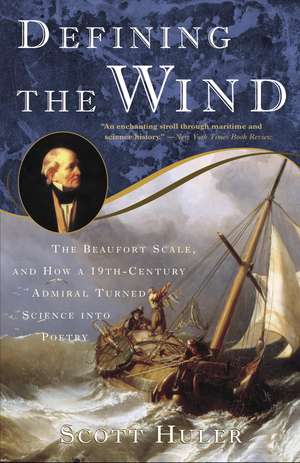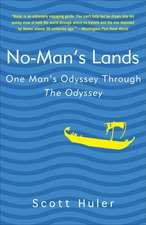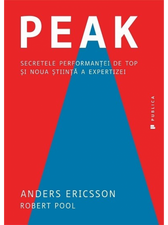Defining the Wind: The Beaufort Scale, and How a 19th-Century Admiral Turned Science Into Poetry
Autor Scott Huleren Limba Engleză Paperback – 31 mai 2005
Preț: 112.64 lei
Nou
Puncte Express: 169
Preț estimativ în valută:
21.55€ • 22.56$ • 17.83£
21.55€ • 22.56$ • 17.83£
Carte tipărită la comandă
Livrare economică 07-21 aprilie
Preluare comenzi: 021 569.72.76
Specificații
ISBN-13: 9781400048854
ISBN-10: 1400048850
Pagini: 290
Ilustrații: 30 LINE DRAWINGS
Dimensiuni: 132 x 203 x 20 mm
Greutate: 0.36 kg
Editura: Three Rivers Press (CA)
ISBN-10: 1400048850
Pagini: 290
Ilustrații: 30 LINE DRAWINGS
Dimensiuni: 132 x 203 x 20 mm
Greutate: 0.36 kg
Editura: Three Rivers Press (CA)
Notă biografică
Scott Huler is the author of On Being Brown and A Little Bit Sideways: One Week Inside a NASCAR Winston Cup Race Team. His work is heard regularly on National Public Radio. He lives in Raleigh, North Carolina.
Extras
Chapter 1
Beaufort of the Admiralty
THE WORST THING about the ferry that runs between Buenos Aires, Argentina, and Montevideo, Uruguay, is that it's a hydrofoil. On the one hand this makes for a fast trip-kicking up twin spumes of seawater, the hydrofoil takes only two and a half hours to go 137 miles across the Rio de la Plata, the world's widest river. But on the other hand, the speed of the boat means they won't let you outdoors. A boat going fifty-five miles per hour kicks up quite a wind (it's Beaufort force 10, if you're wondering: "trees uprooted; considerable structural damage occurs" if you're on land, to say nothing of the terror it would inflict on a straw hat and sunglasses), so the speed prevents you from doing what you naturally want to do on a boat in summer, which is stand on the deck and watch the world go by.
Or, in my case, watch the world come toward you. What I specifically wanted to see was Montevideo, and I wanted to watch it emerge from the vastness of the Rio de la Plata and assert itself on my eye as we approached it from the west, exactly as Sir Francis Beaufort had in 1807. It shouldn't have been hard to see what he wanted me to see-he actually left me directions, and I boarded the boat with a sheaf of maps under my arm and high hopes.
But no soap. The ferry Juan Patricio doesn't even have a deck open to the weather, so the tourist-class passengers are left squinting out of windows with an aerodynamic slant seemingly designed to maximize the reflection of interior seats, carpeting, and the knees and feet of passengers. The window ledge itself reflected a sharp line at almost exactly horizon height as you gazed out the window, and trying to keep the two lines separate, in a boat skipping over water at 55 mph, can actually leave one rather queasy.
I initially envied the first-class passengers, whom I imagined strolling in front of huge banks of flat windows as the broad Rio de la Plata sped regally by beneath the boat, but an earnest look at the attendant, a flourished sketchbook, and a few words of stammered Spanish got me, an accomplice, and my maps upstairs, where I found the passengers had a better snack bar and much wider seats-but no view out the front of the boat at all. So it was back down to steerage and more attempts to find an angle at which I could peer through the windows and see something other than my own annoyed expression reflected back at me.
I ENDED UP TRAVERSING the Rio de la Plata solely because Sir Francis Beaufort had been there before me-he was there in 1807, I in 2002-and I yearned to go where he had been, to see what he had seen.
This wasn't what I had expected. From the scale that bears his name I had naturally presumed Sir Francis-Queen Victoria made him a Knight Commander of the Order of the Bath in 1848, hence the "Sir"-was either a writer or a meteorologist, so I was surprised to find that the standard biography called him Beaufort of the Admiralty. My girlfriend loved the stentorian sound of the title; if she saw me lying on the couch reading it she would wave her arms magisterially and intone "Beaufort . . . of . . . the Admiralty," and I would find it hard to maintain my sense of purpose. The title, though, is exactly right: It's the type of book that instead of merely introducing the first captain under whom Beaufort served-his name was Lestock Wilson-also includes information surrounding Wilson's birth. It's the type of book that has endnotes to its footnotes. If you look in its bibliography, you'll find books like Mr. Barrow of the Admiralty, so the title really just keeps up tradition. In some ways, of course, I
had been right about Beaufort: he was interested in the weather, and he wrote incessantly, if not especially well, filling letters, logs, and journals-and even a book-with prose that swung from the pole of engineer-flat to the tropics of almost absurdly purple without spending much time in the temperate zones.
But above all, Beaufort was a sea captain for the Admiralty-the British Royal Navy-at a moment that put him at the center of one of the greatest cartographic enterprises the world has ever known. In the nineteenth century, while the British merchant and naval fleets were busy taking over the world, Sir Francis Beaufort was the man responsible for making sure they knew what they were getting-for creating charts of the coastlines of the world. The Hydrographic Office of the Admiralty was creating the Admiralty Chart.
An Admiralty Chart, of course, is a map of the sea, or a particular portion of the sea. If you're sailing to, say, Montevideo, you'll get yourself charts prepared by some trustworthy organization-the British Admiralty, the Argentine or United States government-and you'll start planning. The charts showing the largest areas-say, the South Atlantic Ocean-have scales up to about 1:5,000,000, at which size you can see land on both sides of the narrowest part of the Atlantic. By the time you're heading into port at Montevideo, you'll be looking at scales of 1:10,000 or even smaller-close enough to give you soundings demonstrating the best approach to the channel into the harbor, and even showing the docks in easy detail.
An Admiralty Chart, however, is a good way to find your way from Buenos Aires to Montevideo in exactly the same way that the Oxford English Dictionary is a good place to go to find out whether desperate is spelled with an e or an a: it can do that, but it can do an awful lot more. The Admiralty Chart is the gold standard, the true north, the understanding of centuries of navigational and hydrographical lore, distilled into two dimensions and six square feet. "Put your faith in God and your trust in the Admiralty Chart," nineteenth-century sailors would say, and it's worth noting that at that point the Admiralty Chart probably had better long-term prospects. Hydrography is the seagoing sibling of cartography-the cartographer maps the land, the hydrographer draws the coastlines and sounds the sea. Beaufort spent the second half of his career as hydrographer to the Admiralty, the period regarded as the high noon of hydrography. When those sailors resolved to place their trust, they were trusting Sir Francis Beaufort.
ONE WAY TO JUDGE THE MAGNITUDE of Beaufort's contribution to the Admiralty Chart is to compare it with the Beaufort Scale. I found the Beaufort Scale in the Merriam-Webster dictionary, but that's just where I happened to stumble across it. You can find it anywhere.
Open any book about the weather-any book-and you'll find the Beaufort Scale. Look in any navigation manual-there it is. The United States Navy teaches the Beaufort Scale to its midshipmen during their first semester, and virtually every reasonable sailing course includes training in its use.
Kite companies include the Beaufort Scale in their advertising literature. Websites for weather organizations and television stations include the Beaufort Scale.
The Farmer's Almanac contains the Beaufort Scale.
Which makes it somewhat surprising that Beaufort's obituary neglected to mention it even once. And when I say obituary, don't think of the obituaries you're used to seeing in modern newspapers, with a few lines about community organizations and surviving children. On December 17, 1857, in London, Sir Francis Beaufort-admiral, member of the Royal Society, Knight Commander of the Bath, member of an almost staggering number of other scientific societies-died at age eighty-four, surrounded by his family. Less than a month later, the London Daily News ran an obituary, even an appreciation, of Beaufort that received sufficient interest to be reprinted as a pamphlet.
In its reprint version, the encomium runs to sixteen pages.
It never mentions the Beaufort Scale of wind force.
Not once. It discusses the education Beaufort's father provided him. It describes a book he wrote in 1818, it includes a venture in telegraphy in which Beaufort played a role (though it neglects to point out the total, embarrassing failure of that venture), it tells about the first time Beaufort nearly died (which, it turns out, he did quite a lot). But it never mentions the Beaufort Scale.
What it talks about in detail-sixteen pages of detail-is Admiralty Charts. Francis Beaufort made the contribution for which his peers remembered him as a hydrographer. In some ways he was born to it.
FRANCIS BEAUFORT was born, the middle child of seven, to an Irish family in County Meath in 1774. His father was Daniel Augustus Beaufort, descended of fallen French nobility of the Holy Roman Empire. Daniel Augustus was a distracted country parson who dabbled in everything from farming to architecture, even working as a magistrate; church buildings he designed still dot the Irish landscape, and he had bachelor's and master's degrees from Trinity College in Dublin. He eventually received an honorary LL.D. The Beauforts' was the kind of household where French was spoken and the family went to the theater and art exhibits, to readings and demonstrations. Francis's brother grew up to become a classical scholar, his sister a fine artist. As a biography of Daniel Augustus Beaufort says of the family, "no collection of pictures or prints was overlooked, no new play unpatronized, no Handel commemoration unheard, no library, museum or great edifice unvisited." When the first Irish hot-air balloon flight occurred in 1785, the Beauforts were in the crowd-and not long afterwards, Daniel Augustus made and launched a model of the balloon. It caught fire. With an architect for a father, all the children were taught to draw, and when Francis demonstrated an interest in the sea, he was sent to learn the basics of navigation.
Interested in just about everything, Daniel Augustus Beaufort had one remarkable success: he undertook in 1792 to make the first useful complete map of Ireland-though calling it complete is something of an overstatement. Not that it left off natural landmarks like rivers or roads, lakes or harbors; it's just that as a Church of Ireland parson, Beaufort made a map that included every religious structure in Ireland related to his denomination-meanwhile never once including something as inconsequential as, say, Christ Church Cathedral in Dublin, built in 1240.
Still, it appears that the Irish could find their way to church without a map, so the lacunae did not affect its sales. Memoir . . . of Ireland illustrating the Topography of that Kingdom and containing a short Account of its present state civil and ecclesiastical sold thousands of copies and went into several editions.
In fact, young Francis Beaufort even made some of the observations of latitude and longitude for his father's map, after taking several months of study in astronomy with Dr. Henry Ussher, a friend of his father who taught at Trinity College, Dublin. He was identified in the Memoir as "a pupil of Dr. Ussher."
Francis had only occasional traditional schooling, largely because his family had sometimes to flee its home. If the map of Ireland was the first successful map made by the Beaufort family-and the first of many-it was regrettably about the only undertaking Daniel Augustus ever brought to financial success. In the years before he made his map, he had been forced to move his family several times, often overseas to England and Wales, to keep a step ahead of debt collectors.
Yet from the letters Francis and his father exchanged, it appears that the scattered early life Daniel Augustus Beaufort created for him had no ill effects on Francis. All Francis took from his father was the ability to respond to new situations, a vast curiosity-and a profound love of physical observation. He loved to look around-and to write down what he saw.
And from the memories of his family, it appears that Francis Beaufort wanted to make his physical observations from the deck of a ship, and that he wanted that for as long as anyone in his family could remember. "At the age of five," his sister Louisa wrote years later, he "had manifested the most decided preference for the sea, had even refused to learn Latin or any of the rudiments of a learned profession & uniformly persisted in choosing a Naval life"-though she noted that there was no reason to believe Francis at the age of five had ever even seen seawater. Just the same, his father provided for him that training in astronomy essential for navigation, and in 1789, at fourteen, Francis Beaufort set sail as a sort of officer-in-training aboard the Vansittart, an East India Company tradesman bound for China and the Indies.
At least on the front end, the Vansittart had a reasonably successful voyage. It rounded the Cape of Good Hope and made its way to Jakarta, then called Batavia. Chosen to help the captain make astronomical observations to fix the latitude of Batavia, Francis found the observatory there deplorable and wrote home to his father that "a person walking about on the stairs or in . . . any room of the house shakes the Horizon and makes the objects turn about in the Equatorial Telescopes like anything." A central goal of the Vansittart's journey was to survey the Gaspar Strait, just off Sumatra between the islands of Bangka and Belitung; sister ships of the East India Company had been lost there on dangerous and poorly charted shoals, which the Vansittart was to find and chart. Young Francis had been taking bearings and making calculations throughout the journey, and was a help as the ship made the Gaspar Strait survey.
The Vansittart found the shoals, all right-it found them good, running aground and sustaining enough damage that it took on water so rapidly that the crew had to abandon the ship on a reef off a tiny island in the Java Sea. The Malay waters were filled with pirates, so the crew, terrified and perilously short of water, determined to make for a Dutch settlement called Palembang on the northeast coast of Bangka. In the hopes of returning to reclaim the ship's treasure, they threw overboard thirteen treasure chests and piled into open boats, hoping for the best and heading for the Dutch settlement. Along the way one of the boats, with five aboard, became separated and was lost; a vicious squall whipped the remaining boats, and later a group of pirate ships threatened to attack. The crew made it to Palembang, though, where they were relieved to find two British ships anchored in the harbor.
Captain Wilson persuaded the captains of those ships to ferry his crew back to the wreck of the Vansittart to recover what they could, though by the time they reached what remained of the ship, it was just as they had feared: Malay pirates had burned and pillaged it. The crew managed to recover only three of the treasure chests. After that, in the manner of the day, crew members scattered among other ships to make their way back to England. Beaufort ended up in Canton, where he occupied himself for two months making astronomical observations before sailing home with Wilson, arriving back in England a little more than a year after he had set out.
From the Hardcover edition.
Beaufort of the Admiralty
THE WORST THING about the ferry that runs between Buenos Aires, Argentina, and Montevideo, Uruguay, is that it's a hydrofoil. On the one hand this makes for a fast trip-kicking up twin spumes of seawater, the hydrofoil takes only two and a half hours to go 137 miles across the Rio de la Plata, the world's widest river. But on the other hand, the speed of the boat means they won't let you outdoors. A boat going fifty-five miles per hour kicks up quite a wind (it's Beaufort force 10, if you're wondering: "trees uprooted; considerable structural damage occurs" if you're on land, to say nothing of the terror it would inflict on a straw hat and sunglasses), so the speed prevents you from doing what you naturally want to do on a boat in summer, which is stand on the deck and watch the world go by.
Or, in my case, watch the world come toward you. What I specifically wanted to see was Montevideo, and I wanted to watch it emerge from the vastness of the Rio de la Plata and assert itself on my eye as we approached it from the west, exactly as Sir Francis Beaufort had in 1807. It shouldn't have been hard to see what he wanted me to see-he actually left me directions, and I boarded the boat with a sheaf of maps under my arm and high hopes.
But no soap. The ferry Juan Patricio doesn't even have a deck open to the weather, so the tourist-class passengers are left squinting out of windows with an aerodynamic slant seemingly designed to maximize the reflection of interior seats, carpeting, and the knees and feet of passengers. The window ledge itself reflected a sharp line at almost exactly horizon height as you gazed out the window, and trying to keep the two lines separate, in a boat skipping over water at 55 mph, can actually leave one rather queasy.
I initially envied the first-class passengers, whom I imagined strolling in front of huge banks of flat windows as the broad Rio de la Plata sped regally by beneath the boat, but an earnest look at the attendant, a flourished sketchbook, and a few words of stammered Spanish got me, an accomplice, and my maps upstairs, where I found the passengers had a better snack bar and much wider seats-but no view out the front of the boat at all. So it was back down to steerage and more attempts to find an angle at which I could peer through the windows and see something other than my own annoyed expression reflected back at me.
I ENDED UP TRAVERSING the Rio de la Plata solely because Sir Francis Beaufort had been there before me-he was there in 1807, I in 2002-and I yearned to go where he had been, to see what he had seen.
This wasn't what I had expected. From the scale that bears his name I had naturally presumed Sir Francis-Queen Victoria made him a Knight Commander of the Order of the Bath in 1848, hence the "Sir"-was either a writer or a meteorologist, so I was surprised to find that the standard biography called him Beaufort of the Admiralty. My girlfriend loved the stentorian sound of the title; if she saw me lying on the couch reading it she would wave her arms magisterially and intone "Beaufort . . . of . . . the Admiralty," and I would find it hard to maintain my sense of purpose. The title, though, is exactly right: It's the type of book that instead of merely introducing the first captain under whom Beaufort served-his name was Lestock Wilson-also includes information surrounding Wilson's birth. It's the type of book that has endnotes to its footnotes. If you look in its bibliography, you'll find books like Mr. Barrow of the Admiralty, so the title really just keeps up tradition. In some ways, of course, I
had been right about Beaufort: he was interested in the weather, and he wrote incessantly, if not especially well, filling letters, logs, and journals-and even a book-with prose that swung from the pole of engineer-flat to the tropics of almost absurdly purple without spending much time in the temperate zones.
But above all, Beaufort was a sea captain for the Admiralty-the British Royal Navy-at a moment that put him at the center of one of the greatest cartographic enterprises the world has ever known. In the nineteenth century, while the British merchant and naval fleets were busy taking over the world, Sir Francis Beaufort was the man responsible for making sure they knew what they were getting-for creating charts of the coastlines of the world. The Hydrographic Office of the Admiralty was creating the Admiralty Chart.
An Admiralty Chart, of course, is a map of the sea, or a particular portion of the sea. If you're sailing to, say, Montevideo, you'll get yourself charts prepared by some trustworthy organization-the British Admiralty, the Argentine or United States government-and you'll start planning. The charts showing the largest areas-say, the South Atlantic Ocean-have scales up to about 1:5,000,000, at which size you can see land on both sides of the narrowest part of the Atlantic. By the time you're heading into port at Montevideo, you'll be looking at scales of 1:10,000 or even smaller-close enough to give you soundings demonstrating the best approach to the channel into the harbor, and even showing the docks in easy detail.
An Admiralty Chart, however, is a good way to find your way from Buenos Aires to Montevideo in exactly the same way that the Oxford English Dictionary is a good place to go to find out whether desperate is spelled with an e or an a: it can do that, but it can do an awful lot more. The Admiralty Chart is the gold standard, the true north, the understanding of centuries of navigational and hydrographical lore, distilled into two dimensions and six square feet. "Put your faith in God and your trust in the Admiralty Chart," nineteenth-century sailors would say, and it's worth noting that at that point the Admiralty Chart probably had better long-term prospects. Hydrography is the seagoing sibling of cartography-the cartographer maps the land, the hydrographer draws the coastlines and sounds the sea. Beaufort spent the second half of his career as hydrographer to the Admiralty, the period regarded as the high noon of hydrography. When those sailors resolved to place their trust, they were trusting Sir Francis Beaufort.
ONE WAY TO JUDGE THE MAGNITUDE of Beaufort's contribution to the Admiralty Chart is to compare it with the Beaufort Scale. I found the Beaufort Scale in the Merriam-Webster dictionary, but that's just where I happened to stumble across it. You can find it anywhere.
Open any book about the weather-any book-and you'll find the Beaufort Scale. Look in any navigation manual-there it is. The United States Navy teaches the Beaufort Scale to its midshipmen during their first semester, and virtually every reasonable sailing course includes training in its use.
Kite companies include the Beaufort Scale in their advertising literature. Websites for weather organizations and television stations include the Beaufort Scale.
The Farmer's Almanac contains the Beaufort Scale.
Which makes it somewhat surprising that Beaufort's obituary neglected to mention it even once. And when I say obituary, don't think of the obituaries you're used to seeing in modern newspapers, with a few lines about community organizations and surviving children. On December 17, 1857, in London, Sir Francis Beaufort-admiral, member of the Royal Society, Knight Commander of the Bath, member of an almost staggering number of other scientific societies-died at age eighty-four, surrounded by his family. Less than a month later, the London Daily News ran an obituary, even an appreciation, of Beaufort that received sufficient interest to be reprinted as a pamphlet.
In its reprint version, the encomium runs to sixteen pages.
It never mentions the Beaufort Scale of wind force.
Not once. It discusses the education Beaufort's father provided him. It describes a book he wrote in 1818, it includes a venture in telegraphy in which Beaufort played a role (though it neglects to point out the total, embarrassing failure of that venture), it tells about the first time Beaufort nearly died (which, it turns out, he did quite a lot). But it never mentions the Beaufort Scale.
What it talks about in detail-sixteen pages of detail-is Admiralty Charts. Francis Beaufort made the contribution for which his peers remembered him as a hydrographer. In some ways he was born to it.
FRANCIS BEAUFORT was born, the middle child of seven, to an Irish family in County Meath in 1774. His father was Daniel Augustus Beaufort, descended of fallen French nobility of the Holy Roman Empire. Daniel Augustus was a distracted country parson who dabbled in everything from farming to architecture, even working as a magistrate; church buildings he designed still dot the Irish landscape, and he had bachelor's and master's degrees from Trinity College in Dublin. He eventually received an honorary LL.D. The Beauforts' was the kind of household where French was spoken and the family went to the theater and art exhibits, to readings and demonstrations. Francis's brother grew up to become a classical scholar, his sister a fine artist. As a biography of Daniel Augustus Beaufort says of the family, "no collection of pictures or prints was overlooked, no new play unpatronized, no Handel commemoration unheard, no library, museum or great edifice unvisited." When the first Irish hot-air balloon flight occurred in 1785, the Beauforts were in the crowd-and not long afterwards, Daniel Augustus made and launched a model of the balloon. It caught fire. With an architect for a father, all the children were taught to draw, and when Francis demonstrated an interest in the sea, he was sent to learn the basics of navigation.
Interested in just about everything, Daniel Augustus Beaufort had one remarkable success: he undertook in 1792 to make the first useful complete map of Ireland-though calling it complete is something of an overstatement. Not that it left off natural landmarks like rivers or roads, lakes or harbors; it's just that as a Church of Ireland parson, Beaufort made a map that included every religious structure in Ireland related to his denomination-meanwhile never once including something as inconsequential as, say, Christ Church Cathedral in Dublin, built in 1240.
Still, it appears that the Irish could find their way to church without a map, so the lacunae did not affect its sales. Memoir . . . of Ireland illustrating the Topography of that Kingdom and containing a short Account of its present state civil and ecclesiastical sold thousands of copies and went into several editions.
In fact, young Francis Beaufort even made some of the observations of latitude and longitude for his father's map, after taking several months of study in astronomy with Dr. Henry Ussher, a friend of his father who taught at Trinity College, Dublin. He was identified in the Memoir as "a pupil of Dr. Ussher."
Francis had only occasional traditional schooling, largely because his family had sometimes to flee its home. If the map of Ireland was the first successful map made by the Beaufort family-and the first of many-it was regrettably about the only undertaking Daniel Augustus ever brought to financial success. In the years before he made his map, he had been forced to move his family several times, often overseas to England and Wales, to keep a step ahead of debt collectors.
Yet from the letters Francis and his father exchanged, it appears that the scattered early life Daniel Augustus Beaufort created for him had no ill effects on Francis. All Francis took from his father was the ability to respond to new situations, a vast curiosity-and a profound love of physical observation. He loved to look around-and to write down what he saw.
And from the memories of his family, it appears that Francis Beaufort wanted to make his physical observations from the deck of a ship, and that he wanted that for as long as anyone in his family could remember. "At the age of five," his sister Louisa wrote years later, he "had manifested the most decided preference for the sea, had even refused to learn Latin or any of the rudiments of a learned profession & uniformly persisted in choosing a Naval life"-though she noted that there was no reason to believe Francis at the age of five had ever even seen seawater. Just the same, his father provided for him that training in astronomy essential for navigation, and in 1789, at fourteen, Francis Beaufort set sail as a sort of officer-in-training aboard the Vansittart, an East India Company tradesman bound for China and the Indies.
At least on the front end, the Vansittart had a reasonably successful voyage. It rounded the Cape of Good Hope and made its way to Jakarta, then called Batavia. Chosen to help the captain make astronomical observations to fix the latitude of Batavia, Francis found the observatory there deplorable and wrote home to his father that "a person walking about on the stairs or in . . . any room of the house shakes the Horizon and makes the objects turn about in the Equatorial Telescopes like anything." A central goal of the Vansittart's journey was to survey the Gaspar Strait, just off Sumatra between the islands of Bangka and Belitung; sister ships of the East India Company had been lost there on dangerous and poorly charted shoals, which the Vansittart was to find and chart. Young Francis had been taking bearings and making calculations throughout the journey, and was a help as the ship made the Gaspar Strait survey.
The Vansittart found the shoals, all right-it found them good, running aground and sustaining enough damage that it took on water so rapidly that the crew had to abandon the ship on a reef off a tiny island in the Java Sea. The Malay waters were filled with pirates, so the crew, terrified and perilously short of water, determined to make for a Dutch settlement called Palembang on the northeast coast of Bangka. In the hopes of returning to reclaim the ship's treasure, they threw overboard thirteen treasure chests and piled into open boats, hoping for the best and heading for the Dutch settlement. Along the way one of the boats, with five aboard, became separated and was lost; a vicious squall whipped the remaining boats, and later a group of pirate ships threatened to attack. The crew made it to Palembang, though, where they were relieved to find two British ships anchored in the harbor.
Captain Wilson persuaded the captains of those ships to ferry his crew back to the wreck of the Vansittart to recover what they could, though by the time they reached what remained of the ship, it was just as they had feared: Malay pirates had burned and pillaged it. The crew managed to recover only three of the treasure chests. After that, in the manner of the day, crew members scattered among other ships to make their way back to England. Beaufort ended up in Canton, where he occupied himself for two months making astronomical observations before sailing home with Wilson, arriving back in England a little more than a year after he had set out.
From the Hardcover edition.
Recenzii
“[An] enchanting stroll through maritime and science history . . . [Huler is] a charming guide.” —New York Times Book Review
“Huler writes with self-deprecating wit, and . . . he captures the Beaufort scale’s ‘open-hearted intellectual decency.’” —The New Yorker
“On a scale of 0 to 13, this will blow you away . . . Hang on for a lighthearted romp over two hemispheres, two centuries of discovery, and the consuming passions of two men: Beaufort and Huler.” —Seattle Times
“Scott Huler’s obsession with the scale is a match for Beaufort himself. Part history, part textbook, part memoir, Defining the Wind explores how we think about the currents that shape sea and landscapes.” —Los Angeles Times
“[A] reminder of why we read science books. . . . Read Huler and you’ll pay more attention to the air moving through your backyard, fluttering leaves, rattling windows . . . compelling, powerful. . . . ” —Boston Globe
“To some people, the devil is in the details. But a true researcher will revel in the details. That’s what Mr. Huler joyfully discovered in his investigations, and it shows in every page of this unusual and delightful book.” —Dallas Morning News
“Huler writes with self-deprecating wit, and . . . he captures the Beaufort scale’s ‘open-hearted intellectual decency.’” —The New Yorker
“On a scale of 0 to 13, this will blow you away . . . Hang on for a lighthearted romp over two hemispheres, two centuries of discovery, and the consuming passions of two men: Beaufort and Huler.” —Seattle Times
“Scott Huler’s obsession with the scale is a match for Beaufort himself. Part history, part textbook, part memoir, Defining the Wind explores how we think about the currents that shape sea and landscapes.” —Los Angeles Times
“[A] reminder of why we read science books. . . . Read Huler and you’ll pay more attention to the air moving through your backyard, fluttering leaves, rattling windows . . . compelling, powerful. . . . ” —Boston Globe
“To some people, the devil is in the details. But a true researcher will revel in the details. That’s what Mr. Huler joyfully discovered in his investigations, and it shows in every page of this unusual and delightful book.” —Dallas Morning News













